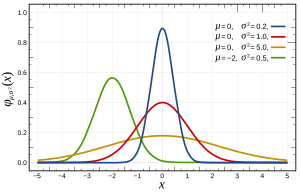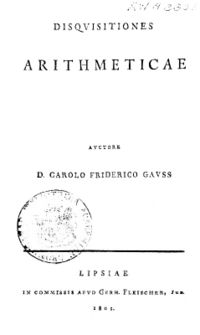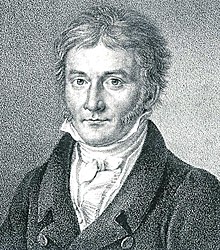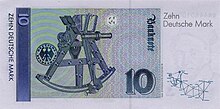Carl Friedrich Gauss
Johann Carl Friedrich Gauss ![]() De-carlfriedrichgauss.ogg (?·i)(Braunschweig, April 30, 1777-Gotinga, February 23, 1855) was a German mathematician, astronomer and physicist who contributed significantly in many areas, including the theory of numbers, mathematical analysis, differential geometry, statistics, algebra, geodesy, magnetism and optics. Considered already in life as Princeps Mathematicorum, prince of mathematicians, Gauss has had a remarkable influence in many fields of mathematics and science. It was among the first to extend the concept of divisibility to other sets in addition to the whole numbers.
De-carlfriedrichgauss.ogg (?·i)(Braunschweig, April 30, 1777-Gotinga, February 23, 1855) was a German mathematician, astronomer and physicist who contributed significantly in many areas, including the theory of numbers, mathematical analysis, differential geometry, statistics, algebra, geodesy, magnetism and optics. Considered already in life as Princeps Mathematicorum, prince of mathematicians, Gauss has had a remarkable influence in many fields of mathematics and science. It was among the first to extend the concept of divisibility to other sets in addition to the whole numbers.
Gauss was soon recognized as a child prodigy, despite coming from a peasant family of parents with little culture: his mother knew how to read, although not write; His father did, but when it came to mathematics, he didn't go beyond the most elementary arithmetic. There are many anecdotes about Carl Friedrich Gauss about his astonishing precocity. He made his first great discoveries in high school, while still a teenager, and completed his magnum opus, Disquisitiones arithmeticae, at the age of twenty-one (1798), although the work was not published until 1801. It constitutes a fundamental work as a consolidation of number theory and has shaped this area to the present day.
Biography
Childhood and youth
Johann Carl Friedrich Gauss was born in the Duchy of Brunswick, Germany, into a humble family. His mother, Dorothea Gauss, née Bentze, was bright, bright-tempered, and strong-willed. She had worked as a maid before becoming the second wife of Gebhard Dietrich Gauss. Her son was closely linked to her, throughout her life. Her father went through many professions; among them, a gardener, butcher, bricklayer, assistant merchant and cashier of a small insurance house.There are anecdotes according to which Carl Friedrich at the age of three was already correcting his father's accounts.
From a very young age, without anyone helping him, at an early age, he assimilated elementary arithmetic very quickly. He himself said, later, that he learned to calculate before speaking. In 1784, at the age of seven, he entered one of the Brunswick elementary schools taught by a country teacher named Büttner, who promptly corrected his reading, taught him the grammar and spelling of Standard High German (since Gauss's native language was Low German), as well as calligraphy, in addition to honing his mathematical talents. He encouraged him to continue his baccalaureate, as recorded in his letter that he wrote to get accepted into the Lyceum. However, his harsh methods and strict discipline intimidated a sensitive boy.
There is an anecdote that, at the age of nine, during arithmetic class, the teacher proposed the problem of adding the numbers from 1 to 100, with the sole purpose of keeping the children entertained. Gauss found the correct answer after a very short time. When the hour was up, the solutions were checked and it was found that Gauss's was correct, while many of his classmates' were not.
He, instead of adding directly, had observed that taking the numbers in pairs, the first and the last, then the second and the penultimate, and so on, you get 100+1 = 99+2 = 98+3 = 101 …, that is, what was asked of him was equivalent to multiplying 101 x 50: little Gauss had discovered the formula for the sum of the terms of an arithmetic progression.
At the age of fourteen, he was presented to the Duke of Brunswick, who decided to help him financially, allowing him to continue his studies at the Collegium Carolinum, an elite school. There he surprised everyone with his facility for languages. He became fluent in Greek and Latin in a very short time. He spent three years at the Collegium and, when he left it, he was not sure if he wanted to dedicate himself to mathematics or philology. At that time he had already discovered his law of least squares, which indicates Gauss's early interest in the theory of observation errors and their distribution.
At the age of seventeen he had his first intuitive ideas about the possibility of another type of geometry. At eighteen, Gauss set about completing what he felt had been left undone by his predecessors in number theory. Thus he discovered his passion for arithmetic, an area in which he soon after had his first triumphs. His taste for arithmetic prevailed throughout his life, since for him "mathematics would be the queen of sciences and number theory would be the queen of mathematics".
Maturity
In 1796 he showed that a 17-sided regular polygon can be drawn with a straightedge and compass.
He was the first to rigorously prove the fundamental theorem of algebra (dissertation for his doctoral thesis in 1799), although an almost complete proof of said theorem had been presented by Jean Le Rond d'Alembert earlier. He delved into differential equations and conic sections.
In 1801 he published the book Disquisitiones arithmeticae, with six sections devoted to number theory, giving this branch of mathematics a systematized structure. In the last section of the book he exposes his doctoral thesis. That same year he predicted the orbit of Ceres by approximating parameters by least squares.The search for the planetoid had aroused great interest in the scientific world.
In 1809 he was appointed director of the Göttingen Observatory, a post he held for the rest of his life, despite the fact that he was not short of interesting offers. In this same year he published Theoria motus corporum coelestium in sectionibus conicis Solem ambientium, describing how to calculate the orbit of a planet and how to refine it later. These methods are a little modified today, mainly because they have been adapted to the use of large computers, but essentially they have not been able to be improved. But Gauss pursued more activities than mathematics and astronomy. He started the Hannover survey, and in the early years he did almost everything himself, field work and data evaluation. With Wilhelm Weber he studied electricity and magnetism, from which he obtained, as a by-product, the telegraph.
In 1835 Carl Friedrich Gauß would formulate Gauss's law, or Gauss's theorem. This law would be one of his most important contributions in the field of electromagnetism, and two of Maxwell's four equations would be derived from it. Many of his results and ideas were not published during his lifetime. He had to be very sure that his work was perfect, guided by the motto & # 34; Pauca sed matura & # 34;, that is, & # 34; Little, but mature & # 34;. Gauss was in favor of the severity of the & # 34; ancient geometers & # 34;, that is, he wanted to derive mathematical statements from a small number of axioms, as Euclid did. His rigor and his style have influenced mathematics to this day.
Personal Life
Gauss married Johanna Elizabeth Rosina Osthoff in 1805. With her he had three children: Carl Joseph (1806 - 1873), Wilhelmina (1808 - 1840) and Louis in September 1809. The mother died the following month as a result of childbirth, and the child in March 1810. Gauß fell into a depression. He remarried in August of that year to Johanna's best friend, Friederica Wilhelmine Waldeck, who died in 1831 after suffering from tuberculosis for thirteen years. With the latter he had three children: the mathematician Eugene (1811-1896), who emigrated to America and founded a bank; Wilhelm August Carl Matthias (1813-1879), who followed his brother and also became rich; and Henriette Wilhelmine Caroline Therese (1816-1864), who took care of the household after the death of her mother and until the death of Gauß, in Göttingen on February 23, 1855.
Religious beliefs
Gauss was a Protestant Lutheran, a member of the Evangelical Lutheran Church of St. Albans in Göttingen. Possible evidence that Gauss believed in God comes from his response after solving a problem that had previously defeated him: Finally, two days ago, I did it-not by my hard efforts, but by the grace of the Lord. One of his biographers, G. Waldo Dunnington, described Gauss's religious views as follows:
For him science was the means of exposing the immortal core of the human soul. In the days of his fullness, he provided him with recreation and, by the perspectives he opened, gave him comfort. Towards the end of his life, he gave him confidence. The God of Gauss was not a cold and distant invention of metaphysics, nor a distorted caricature of bitter theology. Man is not given that fullness of knowledge that would allow him to sustain with arrogance that his blurred vision is the full light and that there can be no other one who can report the truth as his own do. For Gauss, it is not acceptable to the one who murmurs his creed, but to the one who lives it. He believed that a life worthily spent here on earth is the best, the only, preparation for heaven. Religion is not a matter of literature, but of life. God's revelation is continuous, not contained in tables of stone or sacred scrolls. A book is inspired when it inspires. The unshakable idea of personal continuity after death, the firm belief in a last regulator of things, in an eternal, just, omniscient and omnipotent God, constituted the basis of his religious life, which completely harmonized with his scientific research.
Apart from his correspondence, not many details are known about Gauss's personal creed. Many Gauss biographers disagree on his religious stance, with Bühler and others considering him a deist with highly unorthodox views, while Dunnington (admitting that Gauss did not literally believe all Christian dogmas and that he unknown what he believed on most doctrinal and confessional issues) points out that he was, at least, a nominal Lutheran. He writes:
It is not known exactly what Gauss believed in most doctrinal and confessional issues. I didn't literally believe in all Christian dogmas. He was officially a member of the church of San Albano (Pluteran evangelical) in Gottingen. All the baptisms, burials and weddings of his family took place there. Nor is it known whether he attended the church regularly or whether he contributed financially. A college colleague described Gauss as a deist, but there are good reasons to believe that this label didn't fit well. Gauss possessed a strong religious tolerance that moved to every belief originated in the depths of the human heart. This tolerance should not be confused with religious indifference. He was particularly interested in the religious development of the human race, especially in his own century. With regard to the multiple denominations, which often did not coincide with their views, he always stressed that it is not justified to disturb the faith of others, in which they find comfort for earthly suffering and a safe refuge in the days of misfortune.
.
In connection with this, there is a record of a conversation between Rudolf Wagner and Gauss, in which they discussed William Whewell's book Of the Plurality of Worlds. In this work, Whewell had ruled out the possibility of life on other planets, based on theological arguments, but this was a position with which both Wagner and Gauss disagreed. Wagner later explained that he did not fully believe the Bible, though he confessed that he "envyed" the Bible. to those who could easily believe. quote:
League, I think you're more Bible believer than I am. I am not, and, he added, with the expression of a great inner emotion, you are much happier than me. I must say that so many times, in previous times, when I saw people of the lower classes, simple manual workers who could believe so correctly with their hearts, I always envied them, and now, he continued, with a soft voice and that naive childlike way that was peculiar to him, while a tear came to his eyes, tell me how this began...
This later led them to discuss the issue of faith, and in some other religious commentary, Gauss said that he had been more influenced by theologians such as the Lutheran minister Paul Gerhardt than by Moses. Other religious influences included Wilhelm Braubach, Johann Peter Süssmilch and the New Testament. Two religious works that Gauss frequently read were Braubach's Seelenlehre (Giessen, 1843) and Süssmilch's Gottliche (Ordnung gerettet A756); he also devoted considerable time to the New Testament in the original Greek.
Dunnington elaborates on Gauss's religious views writing:
The religious conscience of Gauss was based on an insatiable thirst for truth and a deep sense of justice that extended to both intellectual and material goods. It conceived spiritual life throughout the universe as a great system of law penetrated by eternal truth, and from this source gained firm confidence that death does not end everything.
Gauss stated that he was a firm believer in life after death, and saw spirituality as essentially important to human beings. He was quoted as saying: "The world would be meaningless, the whole creation an absurdity without immortality"
Though not a practicing practitioner, Gauss strongly advocated religious tolerance, believing "it is not justified to disturb another's religious belief, in which one finds solace for earthly sorrows in times of trouble". When his son Eugene announced that he wanted to be a Christian missionary, Gauss approved, saying that regardless of the problems within religious organizations, missionary work was a "highly honorable" undertaking.
Disquisitiones arithmeticae
Gauss's first stay in Göttingen lasted three years, which were among the most productive of his life. He returned to his native Brunswick at the end of 1798 without having received any degree at the University, but by this time his first masterpiece, Disquisitiones arithmeticae , was almost ready though not published. for the first time until 1801.
This book, written in Latin, is dedicated to his patron, Duke Ferdinand, for whom Gauss had great respect and gratitude. It is a treatise on number theory in which all previous work in this area is synthesized and refined. The work consists of 8 chapters but the eighth could not be printed for financial reasons. The fundamental theorem of algebra states that a polynomial in one variable, not constant and with complex coefficients, has as many roots as its degree.
Contributions to the theory of potential
Gauss's divergence theorem, dated 1835 but published in 1867, is fundamental to potential theory and physics. Places in a vector field the volume integral for the divergence of a vector field relative to the surface integral of the vector field around that volume.
Career and achievements
Algebra
In his doctorate in absentia of 1799, A new proof of the theorem that every integral rational algebraic function of a variable can be resolved into real factors of first or second degree, Gauss proved the Fundamental Theorem of algebra that states that every nonconstant monovariable polynomial with complex coefficients has at least one complex root. Mathematicians such as Jean le Rond d'Alembert had produced false proofs before him, and Gauss's dissertation contains a critique of d'Alembert's work. Ironically, by today's standards, Gauss's own attempt is not acceptable, due to the implicit use of the Jordan curve theorem. However, he subsequently produced three other tests, the last of which was in 1849, generally rigorous. His attempts greatly clarified the concept of complex numbers.
Gauss also made important contributions to number theory with his 1801 book Disquisitiones Arithmeticae (Latin, Arithmetic Investigations), which, among other things, introduced the symbol of the "triple bar" ≡ for congruence and used it in a clean presentation of modular arithmetic, contained the first two proofs of the law of quadratic reciprocity, developed theories of binary and ternary quadratic forms, stated the class number problem for them, and showed that a regular heptadecagon (17-sided polygon) can be built with a ruler and compass. It seems that Gauss already knew the class number formula in 1801.
In addition, he proved the following conjectured theorems:
- Theorem of the Polygonal Number of Fermat n = 3
- Last Fermat theorem for n = 5
- Rule of the Signs of Descartes
- Kepler conjecture for regular arrangements
Also
- explained the pentagramma mirificum (see Bielefeld University website)
- developed an algorithm to determine the Easter date
- invented Cooley-Tukey's FFT algorithm to calculate Fourier's discrete Transform 160 years before Cooley and Tukey
Astronomy
On January 1, 1801, Italian astronomer Giuseppe Piazzi discovered the dwarf planet Ceres. Piazzi was able to track Ceres for just over a month, tracking it for three degrees across the night sky. Then it temporarily disappeared behind the glare of the Sun. Several months later, when Ceres should have reappeared, Piazzi could not locate it: the mathematical tools of the time were not capable of extrapolating a position from such a scant amount of data - three degrees represents less than 1% of the total orbit. Gauss learned of the problem and addressed it. After three months of intense work, he predicted a position for Ceres in December 1801—about a year after its first sighting—and it turned out to be accurate to within half a degree when it was rediscovered by Franz Xaver von Zach on December 31 in Gotha, and a day later by Heinrich Olbers in Bremen. This confirmation eventually led to the classification of Ceres as a minor planet with the designation 1 Ceres: the first asteroid (now dwarf planet) ever discovered.
Geodetic survey
In 1818 Gauss, putting his calculus knowledge into practice, carried out a topographical survey of the Kingdom of Hannover, linking up with previous Danish surveys. To aid the survey, Gauss invented the heliotrope, an instrument that uses a mirror to reflect sunlight over great distances, to measure positions.
.
Non-Euclidean geometries
Gauss also claimed to have discovered the possibility of non-Euclidean geometries, but never published it. This discovery marked a major paradigm shift in mathematics, as it freed mathematicians from the mistaken belief that Euclid's axioms were the only way to make geometry coherent and non-contradictory.
Magnetism
In 1831, Gauss developed a fruitful collaboration with physics professor Wilhelm Weber that led to new insights into magnetism (including the search for a representation of the unit of magnetism in terms of mass, charge, and time) and the discovery of Kirchhoff's circuit laws in electricity. It was during this time that he formulated his namesake law. They built the first electromechanical telegraph in 1833, which connected the observatory to the Göttingen Institute of Physics. Gauss ordered the construction of a magnetic observatory in the observatory garden, and with Weber founded the Magnetischer Verein (magnetic association), which supported measurements of the Earth's magnetic field in many regions of the world. He developed a method for measuring the horizontal strength of the magnetic field that was in use well into the second half of the 20th century, and elaborated the mathematical theory for separating the internal and external (magnetospheric) sources of the Earth's magnetic field.
Posts
- 1799: Dissertation on the fundamental theorem of algebra, with the title Demonstratio nova theorematis omnem functionem algebraicam rationalem integram unius variabilis in real factors primi vel secundi gradus resolve posse (New theorem tests where each algebraic integral function of a variable can be solved in real factors first or second grade).
- 1801: Disquisitiones Arithmeticae.
- 1809: Theoria Motus Corporum Coelestium in sectionibus conicis solem atmosphereium (Theory of the movement of the celestial bodies that revolve around the sun in conical sections), trad. to English × C. H. Davis, reprinted in 1963, Dover, NY.
- 1821, 1823 " 1826: Theoria combinationis observationum erroribus minimis obnoxiae. Three presentations concerning the calculation of probability as the basis of the Law of Gauss of the spread of errors. trad. to English × G. W. Stewart, 1987, Society for Industrial Mathematics.
- 1827: Disquisitiones general circa surfaces curves, Commentationes Societatis Regiae Scientiarum Gottingesis Recentiores. Volume VI, pp. 99-146. Raven Press, New York, trad. × A. M. Hiltebeitel & J. C. Morehead.
- 1843/44: Research on higher geodesy objects. First dissertation., Presentations of the Royal Society of Sciences in Gotinga. Second volume, pp. 3-46.
- 1846/47: Research on higher geodesy objects. Second dissertation., Presentations of the Royal Society of Sciences in Gotinga. Third volume, pp. 3-44.
- Mathematisches Tagebuch 1796–1814, Ostwaldts Klassiker, Harri Deutsch Verlag 2005, mit Anmerkungen von Neumamn, ISBN 978-3-8171-3402-1 Mathematical journal. Neumann's annotations.
Eponyms
They are named after the German mathematician:
- The Carl Friedrich Gauss Award, delivered by the UMI (International Mathematical Union) every four years since 2006.
- The gauss is a magnetic field measurement unit. (The Tesla is used in the International Unit System.)
- The Gauss Expedition, the first German expedition to Antarctica, aboard the ship Gauss.
- The Gauss cannon, a type of electromagnet-based cannon.
- GAUSS, a programming language.
- The Gauss Tower or Gaußturman observation tower in Dransfeld, Germany.
- The asteroid (1001) Gaussia
- The lunar crater Gauss
- Physical and mathematical formulas and theorems:
- Gauss' distribution or normal distribution is a probability distribution.
- The Gauss curve, Gauss bell or Gaussian function is a mathematical function that describes the Gauss distribution.
- The law of Gauss relates the electrical flow through a closed surface and the electrical load enclosed on this surface.
- The theorem of divergence, also called Gauss theorem or Gauss-Ostrogradsky theorem, is a theorem that relates the mathematical divergence of a vector field to the value of the surface integral of the flow defined by this field.
- The Gauss-Bonnet theorem is a proposition on surfaces that connects its geometry to its topology.
- The Gauss-Krüger system, in cartography, is synonymous with the Transverse Mercator projection system.
- The Gauss square is an approximation of a defined integral of a function that selects the evaluation points optimally and not in an equally spaced form.
- The elimination of Gauss-Jordan is a linear algebra algorithm to determine the solutions of a linear equation system, find matrices and reverses.
Contenido relacionado
Prism (geometry)
Diego Rodriguez (mathematician)
Archimedes







